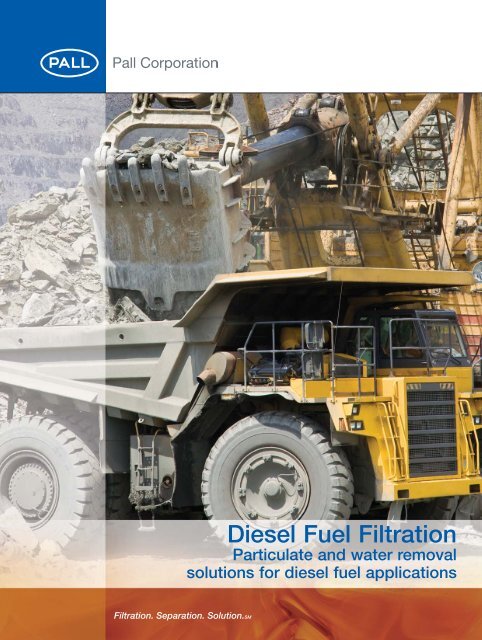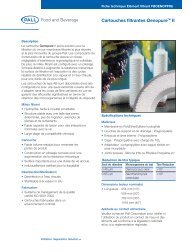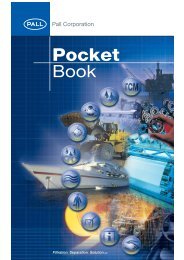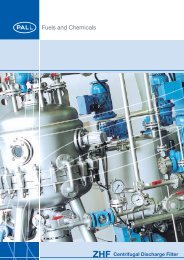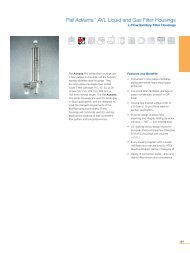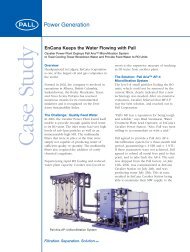Pall Diesel Fuel Filtration - IMDFFEN - Pall Corporation
Pall Diesel Fuel Filtration - IMDFFEN - Pall Corporation
Pall Diesel Fuel Filtration - IMDFFEN - Pall Corporation
Create successful ePaper yourself
Turn your PDF publications into a flip-book with our unique Google optimized e-Paper software.
<strong>Diesel</strong> <strong>Fuel</strong> <strong>Filtration</strong><br />
Particulate and water removal<br />
solutions for diesel fuel applications
<strong>Diesel</strong> <strong>Fuel</strong> <strong>Filtration</strong><br />
Introduction<br />
With increasing operating costs (e.g., fuel usage cost,<br />
equipment downtime cost) and strict environmental legislation<br />
(e.g., GHG emissions), the mining industry faces difficult<br />
challenges when running fleets of large diesel powered<br />
engines. To ensure optimum engine performance and reliability,<br />
particulate and water contamination in diesel fuel must be<br />
controlled to acceptable (specification) limits. Standard<br />
on-board fuel filters are not designed to handle high levels<br />
of contamination. Therefore, to prevent premature plugging<br />
and frequent change-outs of on-board filters, fuel cleanliness<br />
should be controlled throughout the entire fuel supply chain.<br />
The Impact of Particulate Contamination<br />
on <strong>Diesel</strong> Powered Engines<br />
There are three types of engine fuel injection system<br />
failures that can be attributed to the presence of hard,<br />
particulate contamination:<br />
Mechanical failures from component wear and blocking<br />
component movement<br />
Electrical failures (typically as injector solenoid<br />
burnout) from silting around the poppet valve stem,<br />
restricting movement<br />
Performance failures from blocking of injector nozzles<br />
and altering injector spray patterns<br />
<strong>Diesel</strong> Engine <strong>Fuel</strong> Injector Systems<br />
As engine fuel injection technology has progressed,<br />
so has its sensitivity to contamination.<br />
Electronically Controlled Unit Injectors (EUIs)<br />
The injector nozzle openings of EUIs are 6-7 µm in diameter.<br />
These openings can become blocked or suffer erosion from<br />
particulate contamination as diesel fuel is passed through<br />
them at high pressures. Nozzle shape can be changed<br />
or spray patterns altered, adversely impacting engine<br />
performance in the form of reduced power output and<br />
poor fuel economy.<br />
High Pressure Common Rail System (HPCR)<br />
HPCR system technology offers improved power and fuel<br />
efficiency and lower exhaust emissions. To achieve these<br />
results, HPCR systems operate at pressures in excess of 2000<br />
bar and have injector nozzle openings in the 2-3 µm diameter<br />
range. This requires diesel fuel 30 times cleaner than what<br />
is acceptable for standard EUIs and over 100 times cleaner<br />
than what is typically dispensed at the pump. This level of<br />
cleanliness cannot be attained with on-board filtration alone;<br />
supplementary bulk and point of filling filtration is required.<br />
Defining Acceptable <strong>Fuel</strong> Cleanliness Levels<br />
While <strong>Diesel</strong> fuel cleanliness can vary significantly along the<br />
fuel supply chain, one engine manufacturer defines typical<br />
incoming fuel cleanliness at a cleanliness level of 22/20/17<br />
per ISO 4406.<br />
For EUI fuel injection systems, equipment OEMs typically<br />
require a fuel cleanliness level of 18/16/13 per ISO 4406.<br />
New HPCR engines require diesel fuel cleanliness levels<br />
as low as 12/9/6 per ISO 4406.<br />
ISO 22/20/17 ISO 18/16/13 ISO 12/9/6<br />
How Dirty is it Really?<br />
To put this into a more practical perspective, the table below<br />
shows the equivalent contaminant mass and water volume that<br />
would be pumped in one year for a large mine site using 137,000<br />
liters of diesel fuel/day, for various fuel contamination levels.<br />
ISO 4406<br />
Cleanliness Code<br />
Kilograms of<br />
particulate contaminant<br />
pumped per year<br />
22/20/17 20/18/15 18/16/13 12/9/6<br />
800 200 50 0.4<br />
Water Content (ppm) 5000 1000 500 100<br />
Liters of water equivalent<br />
pumped per year<br />
250,000 50,000 25,000 5,000<br />
Thus, if 0.5 % (5000 ppm) of the fuel was water, the mine<br />
would pump approximately 250,000 liters of water, equivalent<br />
to $200K* worth of fuel.<br />
*based on 80 cents per liter<br />
<strong>Diesel</strong> Cleanliness – a Site-Wide Investment<br />
<strong>Diesel</strong> fuel cleanliness control must be a site-wide investment<br />
and managed with advanced particulate and water filtration<br />
technologies, from the point of delivery, through storage,<br />
right up to the dispensing nozzle.<br />
Supplying equipment with diesel fuel at required<br />
cleanliness levels will result in a number of<br />
significant benefits, including:<br />
Improved diesel engine performance and reliability<br />
Improved diesel engine operating costs<br />
Reduced diesel engine maintenance costs<br />
Reduced vehicle downtime<br />
Reduced fuel consumption<br />
Reduced air pollution<br />
<strong>Diesel</strong> fuel cleanliness control -<br />
from delivery, to storage, to pump, to injector...
<strong>Diesel</strong> <strong>Fuel</strong> <strong>Filtration</strong><br />
<strong>Filtration</strong> Applications and Product Positioning<br />
<strong>Fuel</strong> Delivery<br />
Mobile Surface Fleet<br />
Shovels and Loaders<br />
Mobile <strong>Fuel</strong> Trucks<br />
Underground Fleet<br />
Point of Use<br />
<strong>Fuel</strong> Treatment<br />
Particulate<br />
<strong>Filtration</strong><br />
Ultipleat <strong>Diesel</strong><br />
<strong>Fuel</strong> Filters<br />
>300 L/min<br />
(>80 USgpm)<br />
JZ grade<br />
filter medium<br />
Ultipleat<br />
SRT filters<br />
<strong>Pall</strong> <strong>Diesel</strong> <strong>Fuel</strong> <strong>Filtration</strong> Products<br />
Ultipleat <strong>Diesel</strong><br />
<strong>Fuel</strong> Filters<br />
Housing Features<br />
Designed to ASME Section<br />
VIII Div. 1 requirements,<br />
with code stamping<br />
as an available option<br />
10 barg (150 psi) pressure<br />
rated vessels<br />
Carbon Steel and 316<br />
Stainless Steel options<br />
Horizontal and vertical<br />
configurations<br />
Element Features<br />
6" diameter Ultipleat<br />
(wave-shaped pleat)<br />
filter medium pack<br />
In-to-out filter element<br />
flow path<br />
Coreless element<br />
configuration for<br />
environmentally<br />
friendly disposal<br />
<strong>Pall</strong> Aeropower<br />
Nylon Depth Media<br />
<strong>Fuel</strong> Filters<br />
Features<br />
Proprietary polymeric<br />
media with optimized<br />
removal efficiency and<br />
dirt capacity for ‘heavy<br />
duty’ and ‘severe duty’<br />
applications<br />
Compatible with<br />
biodiesel fuels<br />
For fuel flow rates up<br />
to 650 litres per hour<br />
(170 gallons per hour)<br />
Can be configured for<br />
particulate and water<br />
control in a single stage<br />
Available accessories:<br />
- Priming pump<br />
(manual or electrical)<br />
- <strong>Diesel</strong> fuel heater<br />
- Water in fuel sensor<br />
- Pressure sensor/switch<br />
- Temperature sensor<br />
25 Harbor Park Drive<br />
Port Washington, NY 11050<br />
+1 516 484 3600 telephone<br />
+1 888 333 7255 toll free US<br />
Melbourne - Australia<br />
+61 (0)3 9584 8100 telephone<br />
+61 (0)3 9584 6647 fax<br />
dieselfuel@pall.com<br />
Ultipleat SRT<br />
Filters<br />
Housing Features<br />
Auto-pull element removal<br />
mechanism for easy and<br />
fast element removal<br />
Cap or head service<br />
configurations<br />
Element Features<br />
3" and 6" diameter<br />
Ultipleat (wave-shaped<br />
pleat) filter medium pack<br />
Stress Resistant<br />
Technology (SRT) media<br />
for enhanced performance<br />
under cyclic flow and dirt<br />
loading conditions<br />
Anti-static filtration medium<br />
In-to-out filter element<br />
flow path<br />
Coreless element<br />
configuration for<br />
environmentally<br />
friendly disposal<br />
PhaseSep Liquid/Liquid<br />
Coalescers<br />
Features<br />
Unique stacked element<br />
design - separator and<br />
coalescer in one unit<br />
Large diameter<br />
flouropolymer media;<br />
performance not impaired<br />
by the presence of<br />
surfactants or fuel additives<br />
In-to-out flow direction<br />
Wide fluid compatibility<br />
Air Breather Filters<br />
Features<br />
Optimum protection<br />
against airborne<br />
contamination ingression<br />
into vented fluid systems<br />
Suitable for flow rates up to<br />
1500 L/min (400 USgpm)<br />
Further documentation is available at pall.com/mining<br />
<strong>Pall</strong> <strong>Corporation</strong> has offices and plants throughout the world. For <strong>Pall</strong> representatives<br />
in your area, please go to www.pall.com/contact<br />
Because of technological developments related to the products, systems, and/or<br />
services described herein, the data and procedures are subject to change without<br />
notice. Please consult your <strong>Pall</strong> representative or visit www.pall.com to verify that<br />
this information remains valid. Products in this document may be covered by one<br />
or more of the following patent numbers: EP 0 930 926; US 5,480,547; US 6,332,987;<br />
EP 0 667 800; EP 0 982 061; EP 1 380 331; US 5,543,047; US 5,690,765; US 5,725,784;<br />
US 6,113,784; US 7,083,564; US 7,318,800; EP 0 667 800; EP 0 982 061;<br />
EP 1 380 331; US 5,543,047; US 5,690,765; US 5,725,784; US 6,113,784;<br />
US7,083,564; US 7,318,800; EP 1 656 193.<br />
© Copyright 2011, <strong>Pall</strong> <strong>Corporation</strong>. <strong>Pall</strong>, , Phasep and Ultipleat are trademarks of <strong>Pall</strong> <strong>Corporation</strong>.<br />
® indicates a trademark registered in the USA.<br />
ENABLING A GREENER FUTURE.SM and <strong>Filtration</strong>. Separation. Solution.SM are service<br />
marks of <strong>Pall</strong> <strong>Corporation</strong>.<br />
<strong>IMDFFEN</strong>b Produced in the UK January 2011


